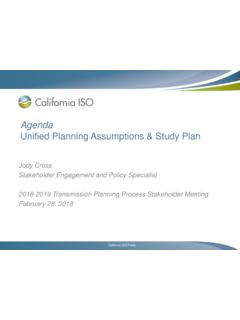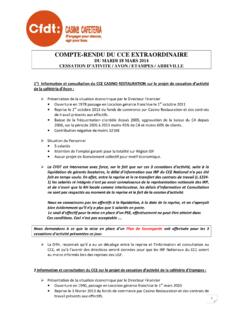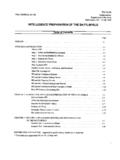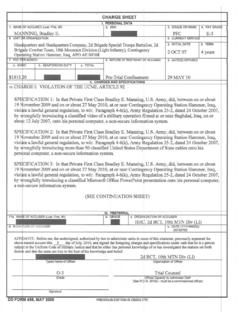Transcription of INTERNATIONAL RADON PROJECT SURVEY ON …
1 1 WHO/HSE/ English only IINNTTEERRNNAATTIIOONNAALL RRAADDOONN PPRROOJJEECCTT SURVEY ON RADON guidelines , PROGRAMMES AND activities FINAL REPORT Health Security and Environment Public Health and Environment Radiation and Environment Health Geneva, 2007 2 Author: Professor Dr Hajo Zeeb Institute of Medical Biometry, Epidemiology and Informatics Mainz University, Germany (Formerly WHO SDE/PHE/RAD) Editors: Dr Ferid Shannoun Dr Zhanat Carr WHO HSE/PHE/RAD Acknowledgement: We thank all respondents who answered to the WHO IRP request to supply data on RADON in their respective countries. Particular thanks to Dr David Fenton, RPII Ireland, for support in SURVEY development and data collection. World Health Organization 2007 All rights reserved. Publications of the World Health Organization can be obtained from WHO Press, World Health Organization, 20 Avenue Appia, 1211 Geneva 27, Switzerland (tel.)
2 : +41 22 791 3264; fax: +41 22 791 4857; e-mail: Requests for permission to reproduce or translate WHO publications whether for sale or for noncommercial distribution should be addressed to WHO Press, at the above address (fax: +41 22 791 4806; e-mail: The designations employed and the presentation of the material in this publication do not imply the expression of any opinion whatsoever on the part of the World Health Organization concerning the legal status of any country, territory, city or area or of its authorities, or concerning the delimitation of its frontiers or boundaries. Dotted lines on maps represent approximate border lines for which there may not yet be full agreement. The mention of specific companies or of certain manufacturers products does not imply that they are endorsed or recommended by the World Health Organization in preference to others of a similar nature that are not mentioned. Errors and omissions excepted, the names of proprietary products are distinguished by initial capital letters.)
3 All reasonable precautions have been taken by the World Health Organization to verify the information contained in this publication. However, the published material is being distributed without warranty of any kind, either expressed or implied. The responsibility for the interpretation and use of the material lies with the reader. In no event shall the World Health Organization be liable for damages arising from its use. Respondents have answered to the best of their knowledge. The information given does not always represent an official statement of behalf of the country concerned. Errors are solely the responsibility of respondents and the author of the report. Printed by the WHO Document Production Services, Geneva, Switzerland 3 Summary Under the framework of the WHO INTERNATIONAL RADON PROJECT , WHO conducted a SURVEY on indoor RADON among WHO member states in 2005. This report includes the detailed responses of 36 countries that returned the questionnaires.
4 Among other, information on the mean RADON levels in the different countries as well as on RADON action/reference levels is provided. The values for action levels show a wide range, but most frequently RADON concentrations between 100 and 400 Bq/m3 are being used as action level. Many countries have opted for lower levels for new buildings as compared to slightly higher levels for existing buildings. Questions concerning RADON measurement as well as mitigation and prevention guidelines were also part of the SURVEY . Many different activities and approaches to RADON risk communication were reported by the participating countries, but only some countries have evaluated these activities . 4 Contents: Introduction and background Section 1 guidelines Section 2 RADON levels Section 3 Measurement, mitigation and prevention Section 4 RADON Risks: Communication and Awareness-Raising Detailed Data abstracted from the questionnaires Annex: Original detailed questionnaire List of Figures: Figure 1: Existence of action or reference levels for indoor RADON Figure 2a: RADON action (reference) levels in existing buildings Figure 2b: RADON action (reference) levels for new buildings Figure 3: Building codes for new dwellings Figure 4: Types of detectors used in countries Figure 5.
5 Evaluation of risk communication activities 5 Introduction and background A SURVEY on detailed aspects of RADON programs was sent to countries and scientists worldwide making use of the network of INTERNATIONAL RADON PROJECT (IRP)1 participants and following the responses to a global mini- SURVEY distributed through WHO to its 192 member countries. To this mini- SURVEY 75 countries out of 192 Member States responded ( ), and 45 of the responding countries indicated that they have some RADON related activities in their country. The full SURVEY was sent to all 45 countries that had responded positively to the mini- SURVEY . 36 countries provided detailed information to all or some of the questions. One country (Cyprus) indicated that they had no ongoing RADON program but had previously assessed the national situation with regard to RADON . A short summary on the different sections of the questionnaire is provided below, followed by the detailed data concerning the different sections of the questionnaire.
6 Section 1 guidelines Action (Reference) levels for RADON (answers from 35 countries): The questionnaire was aimed at countries with existing RADON activities . In more than three quarter of these countries action levels exist, mostly in the range 200-400 Bq/m3 for existing homes and, with few exceptions, at 200 Bq/m3 for new buildings. For existing buildings only a small number of responding countries define the action levels as compulsory. For new buildings this number is slightly larger, as at least 4 countries have compulsory levels for new buildings as against voluntary levels in existing buildings (Denmark, Finland, Norway, UK). Germany and the USA currently have the lowest action level values; at 100 and 148 Bq/m respectively (Data from Ecuador were somewhat contradictory). The German value is, however, not yet legally binding. 1 Responding to the new evidence from the case-control studies on residential RADON and lung cancer risk, WHO launched the INTERNATIONAL RADON PROJECT in 2005.
7 For detailed description of the PROJECT see: 6 Figure 1: Existence of action or reference levels for indoor RADON 77%23%YesNo In countries with compulsory action/reference levels, there is a wide spectrum of activities that are considered once the relevant level is found to be exceeded. It appears that only very few countries specify activities to be undertaken, and there are often several public agencies involved in advising the householder and guiding/evaluating mitigation actions. Specified target levels post mitigation are commonly set to below the reference level in the country concerned, but there are several countries that do not specify such levels, aiming instead at the maximum reduction practically possible without giving target values. Several countries such as Norway and Switzerland define comparatively low target levels (50 and 100 Bq/m3, respectively) for new buildings post mitigation or installation of preventive measures.
8 7 Figure 2a: RADON action (reference) levels in existing buildings (Bq/m3) 02468101214<200200400>400 NOFrequency Figure 2b: RADON action (reference) levels for new buildings (Bq/m3) 0510152025<200200400 NOFrequency Note: < 200 Bq/m3 includes Germany (new legislation planned) 8 Finland, the Czech Republic, Kyrgyzstan Latvia, Norway, Sweden and Switzerland are among the few countries where action levels exist beyond which RADON mitigation is judged to be always justified. Rarely, a definite time frame is given for remedial action to be completed. Finland prescribes a time frame depending on the actual RADON level found, and houses with high RADON levels above 5000 Bq/m3 to be remediated within a short period after identification of the problem. Switzerland generally allows several years for the remediation to be completed in existing homes with high RADON concentrations. 15 out of 33 responding countries indicate that they have building regulations for new buildings in place.
9 Very few countries have conducted scientific assessments of the effect of these codes, with results generally giving an indication of a positive effect towards lowering indoor RADON concentrations. There are very few countries (9%) at present where a RADON measurement during new building construction is mandatory at least in parts of the country. The financial burden of mitigation and RADON prevention work is almost exclusively carried by the house owner, and very few countries, notably the Czech Republic and Belgium, have state grant schemes (ongoing or in the past). Figure 3: Building codes for new dwellings 45%55%0%YesNo 9 Similarly the inclusion of RADON issues in buying or selling of existing and of new homes is currently not widespread, however, the proportion of countries requiring information on RADON or RADON measurements in transactions concerning new buildings is larger (6 out of 29) than the respective proportion with focus on existing buildings (2/29).
10 Section 2 RADON levels 32 countries supplied information on mean RADON levels, but for a few countries the given values are probably not representative since they are based on small studies and/or specific areas. The world-wide variation of RADON levels is well known, and the SURVEY includes both countries with mean RADON concentrations in homes around or above 100 Bq/m3 ( Czech Republic, Ireland) and countries with low average RADON levels ( Japan, UK). It should be noted that there are also major within-country variations that are not well captured by single-value averages. The average indoor RADON concentration value of 26 countries with data on a presumably representative basis was Bq/m3. Section 3 Measurement, mitigation and prevention For 33 countries, information on the main types of detectors used for RADON measurement was available. The majority used more than one type, with the alpha track being the most commonly used by all countries.

















